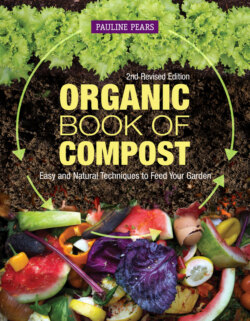Читать книгу Organic Book of Compost - Pauline Pears - Страница 6
На сайте Литреса книга снята с продажи.
ОглавлениеINTRODUCTION
Composting makes the world go round. It recycles the nutrients that make plants (and animals) grow, feeds the bugs that keep the soil healthy and is a sustainable, low-cost way of dealing with “rubbish that rots.” And it can be fun too.
Looking at a handful of compost you might wonder what all the fuss is about. How could a whole book be written about something that looks like “dirt.” How can people be so passionate about a process that goes on in the natural world all the time? We hope that by the time you have made your first batch of compost you will be equally inspired – or at the very least feel that it is something worth doing again.
WHAT IS GARDEN COMPOST?
It is important to be clear about what is meant by the word “compost.” Compost, which looks like a rich dark-brown soil, is a product that results from the slow decomposition of plant and animal matter by living organisms. It is nature’s way of recycling the nutrients that exist in all living plants and animals and returning them to the soil to enrich and feed further generations of flora and fauna.
Compost is not the same as the seed, potting and multi-purpose composts on sale in garden shops. These, which are more correctly called growing media, are carefully formulated mixtures, designed for the specific purpose of raising and growing plants.
Compost-making is for everyone. You don’t need to be a keen gardener or have a science degree – the advice and instructions in this book are given in clear and simple terms.
A METHOD FOR EVERY SITUATION
Compost can be made in back yards, small or large gardens, school playgrounds, and on balconies and boats. This book has methods to suit every situation – including cool heaps, worm composting, Bokashi treatment and compost tumblers. There are also techniques to fit a range of lifestyles. Some composting methods involve little time and effort, while others can be turned into an enjoyable hobby. Choose the one that suits you and your family best; composting can be a great activity for children too. If you are new to composting, this book will show you how to get started, using a method that suits the range of items that you have available to compost. Within the chapter entitled “Getting Started” there is a flow chart to help you choose the method that suits your circumstances (see here). If you have already tried making compost and are not satisfied with the results, this book will help you to work out what you need to do to achieve your aims.
Composting need not involve much work. Heap suitable materials into a compost bin and let nature do the rest.
Compost is such wonderful stuff that it is often referred to as “black gold.”
There is a chapter on composting containers and where to put them, a chapter devoted to worm composting, and one on other techniques and treatments with full instructions on how to proceed. There is also a chapter focused on the helpful creatures that live in your compost and how they do their work.
“Can I compost it?” is a frequently asked question. At the heart of this book is an invaluable chart to refer to when you are unsure if a particular item is suitable for composting. This list might also encourage you to compost and recycle items that you might not have thought of before (see “What can I compost” here).
Making compost, leaf mold and so on should not be an end in itself. The recycling process is only really complete when the product is put back on to the soil (or into your pots and containers), and the plant foods it contains are used again by growing plants. This book also includes advice on how to make best use of the products you have made.
A handful of worm compost will pep up a hanging basket.
